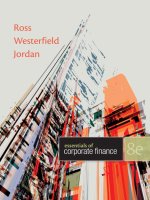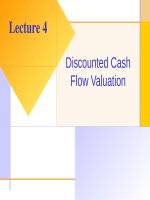Lecture Essentials of corporate finance (2/e) – Chap 3: Working with financial statements
Bạn đang xem bản rút gọn của tài liệu. Xem và tải ngay bản đầy đủ của tài liệu tại đây (665.33 KB, 37 trang )
Working with financial
statements
Chapter 3
Key concepts and skills
• Know how to standardise financial
statements for comparison purposes
• Know how to compute and interpret
important financial ratios
• Know the determinants of a firm’s
profitability and growth
• Understand the problems and pitfalls in
financial statement analysis
Copyright © 2011 McGraw-Hill Australia Pty Ltd
PPTs t/a Essentials of Corporate Finance 2e by Ross et al.
Slides prepared by David E. Allen and Abhay K. Singh
3-2
Chapter outline
•
•
•
•
•
Standardised financial statements
Ratio analysis
The Du Pont identity
Internal and sustainable growth
Using financial statement information
Copyright ©2011 McGraw-Hill Australia Pty Ltd
PPTs t/a Essentials of Corporate Finance 2e by Ross et al.
Slides prepared by David E. Allen and Abhay K. Singh
3-3
Standardised financial
statements
• Common-size balance sheets
– Compute all accounts as a percentage of total
assets
• Common-size income statements
– Compute all line items as a percentage of
sales
• Standardised statements make it easier to
compare financial information, particularly
as the company grows.
• They are also useful for comparing
companies of different sizes, particularly
within the same industry.
Copyright © 2011 McGraw-Hill Australia Pty Ltd
PPTs t/a Essentials of Corporate Finance 2e by Ross et al.
Slides prepared by David E. Allen and Abhay K. Singh
3-4
Swagman Camping Ltd
Balance sheet—Table 3.1
Copyright © 2011 McGraw-Hill Australia Pty Ltd
PPTs t/a Essentials of Corporate Finance 2e by Ross et al.
Slides prepared by David E. Allen and Abhay K. Singh
3-5
Swagman Camping Ltd (cont.)
Common-size balance sheet—
Table 3.2
Copyright © 2011 McGraw-Hill Australia Pty Ltd
PPTs t/a Essentials of Corporate Finance 2e by Ross et al.
Slides prepared by David E. Allen and Abhay K. Singh
3-6
Swagman Camping Ltd (cont.)
Income statement—Table 3.3
Copyright © 2011 McGraw-Hill Australia Pty Ltd
PPTs t/a Essentials of Corporate Finance 2e by Ross et al.
Slides prepared by David E. Allen and Abhay K. Singh
3-7
Swagman Camping Ltd (cont.)
Common-size income statement—
Table 3.4
Copyright © 2011 McGraw-Hill Australia Pty Ltd
PPTs t/a Essentials of Corporate Finance 2e by Ross et al.
Slides prepared by David E. Allen and Abhay K. Singh
3-8
Ratio analysis
• Allows for better comparison over time or
between companies
• Used both internally and externally
• For each ratio, several questions arise:
– How is it computed ?
– What is the ratio trying to measure and why is
that information important?
– What is the unit of measurement?
– What might a high or low value be telling us?
How might such values be misleading?
– How could this measure be improved?
Copyright © 2011 McGraw-Hill Australia Pty Ltd
PPTs t/a Essentials of Corporate Finance 2e by Ross et al.
Slides prepared by David E. Allen and Abhay K. Singh
3-9
Categories of financial
ratios
• Short-term solvency or liquidity ratios
• Long-term solvency or financial
leverage ratios
• Asset management or turnover ratios
• Profitability ratios
• Market value ratios
Copyright © 2011 McGraw-Hill Australia Pty Ltd
PPTs t/a Essentials of Corporate Finance 2e by Ross et al.
Slides prepared by David E. Allen and Abhay K. Singh
3-10
Common financial ratios
Table 3.5
Copyright © 2011 McGraw-Hill Australia Pty Ltd
PPTs t/a Essentials of Corporate Finance 2e by Ross et al.
Slides prepared by David E. Allen and Abhay K. Singh
3-11
Short-term solvency or
liquidity ratios
ASSETS
Current Assets
Cash
Accounts Receivable
Inventory
Total
Fixed Assets
Net Plant & Equipment
Total Asets
SWAGMAN CAMPING LTD
Balance Sheet -2010
Liabilities & Owners Equity
Current Liabilities
$
98
Accounts Payable
$
188
Notes Payable
$
422
Total
$
708
Long term debt
Owners' Equity
Common Stock and paid in surplus
Retained Earnings
$
2,880
Total
$
3,588
Total Liabilties & Owners' Equity
$
$
$
$
344
196
540
457
$
$
$
$
550
2,041
2,591
3,588
• Current ratio = Current assets / Current liabilities
708 / 540 = 1.31 times
• Quick ratio (or acid-test ratio) = (Current assets –
Inventory) / Current liabilities
(708-422) / 540 = 0.53 times
• Cash ratio= Cash / Current liabilities
98/ 540 = 0.18 times
Copyright © 2011 McGraw-Hill Australia Pty Ltd
PPTs t/a Essentials of Corporate Finance 2e by Ross et al.
Slides prepared by David E. Allen and Abhay K. Singh
3-12
Long-term solvency
measures
ASSETS
Current Assets
Cash
Accounts Receivable
Inventory
Total
Fixed Assets
Net Plant & Equipment
Total Asets
•
SWAGMAN CAMPING LTD
Balance Sheet -2010
Liabilities & Owners Equity
Current Liabilities
$
98
Accounts Payable
$
188
Notes Payable
$
422
Total
$
708
Long term debt
Owners' Equity
Common Stock and paid in surplus
Retained Earnings
$
2,880
Total
$
3,588
Total Liabilties & Owners' Equity
$
$
$
$
344
196
540
457
$
$
$
$
550
2,041
2,591
3,588
Total debt ratio
–
(TA – TE) / TA
(3588-2591) / 3588 = 0.28 times
•
Debt/Equity
–
TD / TE
0.28/0.72) = 0.39 times
•
Equity multiplier
–
TA/TE = 1 + D/E
($1 /0.72) = 1.39
Copyright © 2011 McGraw-Hill Australia Pty Ltd
PPTs t/a Essentials of Corporate Finance 2e by Ross et al.
Slides prepared by David E. Allen and Abhay K. Singh
3-13
Long-term solvency measures
(cont.)
SWAGMAN CAMPING LTD
Income Statement - 2010
Sales
$
2,311
COGS
$
1,344
Depreciation
$
276
EBIT
$
691
Interest
$
141
Taxable Income
$
550
Taxes
$
165
Net Income
$
385
Dividends
Addition to RE
$
$
143
242
• Times interest earned
– EBIT/Interest
691/ 141 = 4.9 times
• Cash coverage
– (EBIT + Depreciation)/Interest
(691 + 276) / 141 = 6.9 times
Copyright © 2011 McGraw-Hill Australia Pty Ltd
PPTs t/a Essentials of Corporate Finance 2e by Ross et al.
Slides prepared by David E. Allen and Abhay K. Singh
3-14
Asset management:
Inventory ratios
ASSETS
Current Assets
Cash
Accounts Receivable
Inventory
Total
Fixed Assets
Net Plant & Equipment
Total Asets
SWAGMAN CAMPING LTD
Balance Sheet -2010
Liabilities & Owners Equity
Current Liabilities
$
98
Accounts Payable
$
344
$
188
Notes Payable
$
196
$
422
Total
$
540
$
708
Long term debt
$
457
Owners' Equity
Common Stock and paid in surplus
$
550
Retained Earnings
$ 2,041
$ 2,880
Total
$ 2,591
$ 3,588
Total Liabilties & Owners' Equity
$ 3,588
SWAGMAN CAMPING LTD
Income Statement - 2010
Sales
$ 2,311
COGS
$ 1,344
Depreciation
$
276
EBIT
$
691
Interest
$
141
Taxable Income $
550
Taxes
$
165
Net Income
$
385
Dividends
Addition to RE
$
$
143
242
• Inventory turnover = Cost of goods
sold/Inventory
1344/422 = 3.2 times
• Days’ sales in inventory = 365/Inventory
turnover
Copyright © 2011 McGraw-Hill Australia Pty Ltd
PPTs t/a Essentials of Corporate Finance 2e by Ross et al.
Slides prepared by David E. Allen and Abhay K. Singh
365 / 3.2 = 114 days
3-15
Asset Management:
Receivables Ratios
ASSETS
Current Assets
Cash
Accounts Receivable
Inventory
Total
Fixed Assets
Net Plant & Equipment
Total Asets
SWAGMAN CAMPING LTD
Balance Sheet -2010
Liabilities & Owners Equity
Current Liabilities
$
98
Accounts Payable
$
344
$
188
Notes Payable
$
196
$
422
Total
$
540
$
708
Long term debt
$
457
Owners' Equity
Common Stock and paid in surplus
$
550
Retained Earnings
$ 2,041
$ 2,880
Total
$ 2,591
$ 3,588
Total Liabilties & Owners' Equity
$ 3,588
SWAGMAN CAMPING LTD
Income Statement - 2010
Sales
$
2,311
COGS
$
1,344
Depreciation
$
276
EBIT
$
691
Interest
$
141
Taxable Income $
550
Taxes
$
165
Net Income
$
385
Dividends
Addition to RE
$
$
143
242
• Receivables Turnover = Sales/Accounts
Receivable
2311 / 188= 12.3 times
• Days’ Sales in Receivables = 365/Receivables
Turnover
Copyright ©2011 McGraw-Hill Australia Pty Ltd
PPTs t/a Essentials of Corporate Finance 2e by Ross et al
Slides prepared by David E Allen and Abhay K Singh
365 / 12.3= 30 days
3-16
Asset management:
Asset turnover ratios
ASSETS
Current Assets
Cash
Accounts Receivable
Inventory
Total
Fixed Assets
Net Plant & Equipment
Total Asets
•
SWAGMAN CAMPING LTD
Balance Sheet -2010
Liabilities & Owners Equity
Current Liabilities
$
98
Accounts Payable
$
344
$
188
Notes Payable
$
196
$
422
Total
$
540
$
708
Long term debt
$
457
Owners' Equity
Common Stock and paid in surplus
$
550
Retained Earnings
$ 2,041
$ 2,880
Total
$ 2,591
$ 3,588
Total Liabilties & Owners' Equity
$ 3,588
SWAGMAN CAMPING LTD
Income Statement - 2010
Sales
$
2,311
COGS
$
1,344
Depreciation
$
276
EBIT
$
691
Interest
$
141
Taxable Income $
550
Taxes
$
165
Net Income
$
385
Dividends
Addition to RE
$
$
143
242
Total asset turnover (TAT) = Sales/Total assets
– 2311/3588 = 0.64 times
•
•
Measure of asset use efficiency
Not unusual for TAT <1, especially if a firm has a large amount of
fixed assets
•
Capital intensity ratio = 1/TAT
– 1/0.64 = 1.56
Copyright © 2011 McGraw-Hill Australia Pty Ltd
PPTs t/a Essentials of Corporate Finance 2e by Ross et al.
Slides prepared by David E. Allen and Abhay K. Singh
3-17
Profitability measures
SWAGMAN CAMPING LTD
Balance Sheet -2010
ASSETS
Current Assets
Liabilities & Owners Equity
Current Liabilities
Cash
$
98
Accounts Receivable
$
188
Inventory
$
422
$
708
Total
SWAGMAN CAMPING LTD
Income Statement - 2010
Net Plant & Equipment
Total Asets
$
2,880
$
3,588
$
2,311
COGS
$
1,344
Accounts Payable
$
344
Depreciation
$
276
Notes Payable
$
196
EBIT
$
691
Total
$
540
Interest
$
141
Long term debt
$
457
Taxable Income
$
550
Taxes
$
165
Net Income
$
385
Owners' Equity
Fixed Assets
Sales
Common Stock and paid in surplus
$
550
Retained Earnings
$
2,041
$
2,591
Dividends
$
143
$
3,588
Addition to RE
$
242
Total
Total Liabilties & Owners' Equity
• Profit margin = Net income/Sales
385/2311 = 16.7%
• Return on assets (ROA) = Net income/Total assets
385/3588 = 10.73%
• Return on equity (ROE) = Net income/Total equity
363 / 2591 = 14.9%
Copyright © 2011 McGraw-Hill Australia Pty Ltd
PPTs t/a Essentials of Corporate Finance 2e by Ross et al.
Slides prepared by David E. Allen and Abhay K. Singh
3-18
Market value measures
• Market price = $88 per share = PPS
• Shares outstanding = 35 million
• Earnings per share = EPS = Net income/Shares
outstanding
– 385/35 = $11
• PE ratio = Price per share (PPS )/ Earnings per share
(EPS)
– $88 / $11 = 8 times
• Market-to-book ratio = Market value per share/ Book
value per share
– Book value per share = Total equity/Shares outstanding
= $2591/35 = $74
– Market-to-book
= $88/74
= Ltd
1.19 times
Copyright
© 2011 McGraw-Hill
Australia Pty
PPTs t/a Essentials of Corporate Finance 2e by Ross et al.
Slides prepared by David E. Allen and Abhay K. Singh
3-19
Swagman ratios
SWAGMAN CAMPING LTD RECAP
Liquidity Ratios
Financial Leverage Ratios
Current Ratio
1.31
Total Debt Ratio
0.28
Quick Ratio
0.53
Debt to Equity
0.39
Cash Ratio
0.18
Equity Multiplier
1.39
Asset Management Ratios
Times Interest Earned
4.9
Inventory Turnover
3.20
Cash Coverage
6.9
Days' Sales in Inventory
114
Profitability Measures
Receivables Turnover
12.30
Profit Margin
16.70%
Days' Sales in Receivables
30
ROA
10.73%
Total Asset Turnover
0.64
ROE
14.90%
Capital Intensity Ratio
1.56
Market Value Measures
Market Price
$ 88.00
Shares Outstanding
35 m
EPS
$ 11.00
PE Ratio
8.0
Book value per share
$74.00
Market to Book
1.19
Copyright © 2011 McGraw-Hill Australia Pty Ltd
PPTs t/a Essentials of Corporate Finance 2e by Ross et al.
Slides prepared by David E. Allen and Abhay K. Singh
3-20
The Du Pont identity
• Return on equity (ROE) = Net income (NI)/
Total equity (TE)= Basic formula
• Du Pont identity
– ROE = Profit margin (PM) * Total asset
turnover (TAT) * Equity multiplier (EM)
• PM = Net income / Sales
• TAT = Sales / Total assets
• EM = Total assets / Total equity
ROE
NI
Sales
Sales
TA
Copyright © 2011 McGraw-Hill Australia Pty Ltd
PPTs t/a Essentials of Corporate Finance 2e by Ross et al.
Slides prepared by David E. Allen and Abhay K. Singh
TA
TE
NI
TE
3-21
Using the Du Pont identity
• ROE = PM*TAT*EM
– Profit margin (PM) is a measure of a firm’s
operating efficiency—how well it controls
costs.
– Total asset turnover (TAT) is a measure of
the firm’s asset-use efficiency—how well it
manages its assets.
– Equity multiplier (EM) is a measure of the
firm’s financial leverage.
Copyright © 2011 McGraw-Hill Australia Pty Ltd
PPTs t/a Essentials of Corporate Finance 2e by Ross et al.
Slides prepared by David E. Allen and Abhay K. Singh
3-22
SWAGMAN—Du Pont
identity
SWAGMAN CAMPING LT D RECAP
Liquidity Ratios
Financial Leverage Ratios
Current Ratio
1.31
Total Debt Ratio
0.28
Quick Ratio
0.53
Debt to Equity
0.39
Cash Ratio
0.18
Equity Multiplier
1.39
Asset Management Ratios
Times Interest Earned
4.9
Inventory Turnover
3.20
Cash Coverage
6.9
Days' Sales in Inventory
114
Profitability Measures
Receivables Turnover
12.30
Profit Margin
16.70%
Days' Sales in Receivables
30
ROA
10.73%
Total Asset Turnover
0.64
ROE
14.90%
Capital Intensity Ratio
1.56
Market Value Measures
Market Price
$ 88.00
Shares Outstanding
35 m
EPS
$ 11.00
PE Ratio
8.0
Book value per share
$74.00
Market to Book
1.19
•
ROE = PM * TAT * EM
– PM = 16.7%
– TAT = .64
– EM = 1.39
•
ROE = .167 x .64 x 1.39
= .149= 14.9%
Copyright © 2011 McGraw-Hill Australia Pty Ltd
PPTs t/a Essentials of Corporate Finance 2e by Ross et al.
Slides prepared by David E. Allen and Abhay K. Singh
3-23
An expanded Du Pont analysis
Table 3.6
Copyright © 2011 McGraw-Hill Australia Pty Ltd
PPTs t/a Essentials of Corporate Finance 2e by Ross et al.
Slides prepared by David E. Allen and Abhay K. Singh
3-24
An expanded Du Pont analysis
(cont.)—Figure 3.1
Copyright © 2011 McGraw-Hill Australia Pty Ltd
PPTs t/a Essentials of Corporate Finance 2e by Ross et al.
Slides prepared by David E. Allen and Abhay K. Singh
3-25









